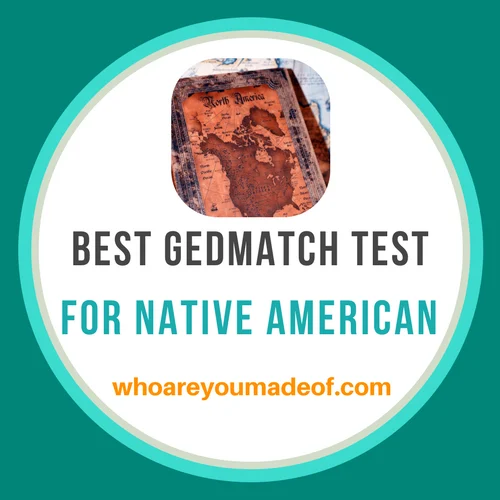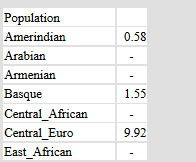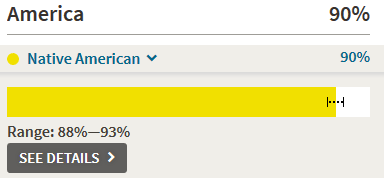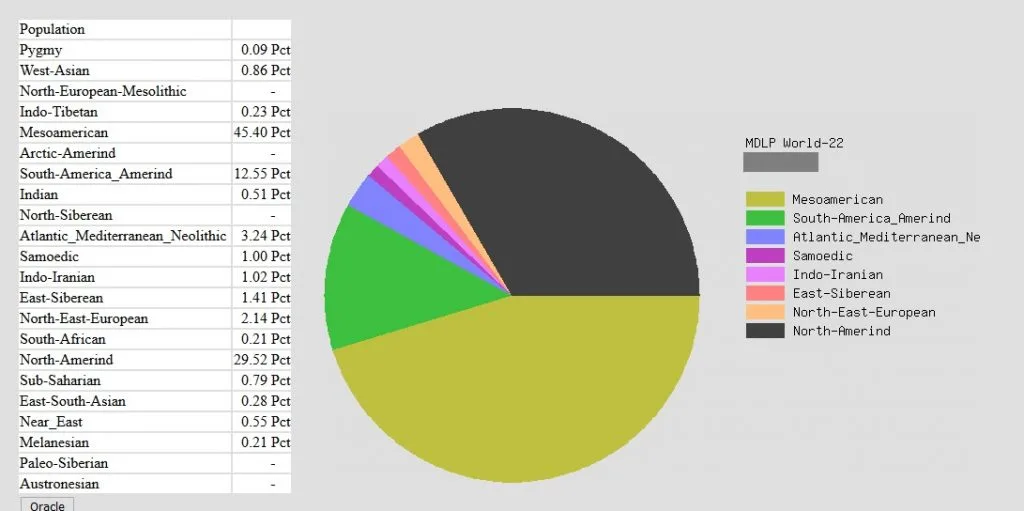In this article, you will learn the basics about what makes the Gedmatch admixture results different than the ones provided by your testing company in your ethnicity estimate, and which admixture calculator is the best Gedmatch test for Native American.
One of the most popular reasons for people to upload their DNA to Gedmatch is to utilize the alternative admixture calculators on the site in order to find trace Native American ancestry.

(Still haven't uploaded your DNA to Gedmatch? Click here to learn how to do it. Want to learn what Gedmatch is? Click here.)
Why doesn't my Native American ancestry show up in my ethnicity results?
I am in the planning process of an entire article dedicated to this question, but for now:
If you were expecting to find Native American ancestry in your DNA ethnicity estimate and you found none, there are two main reasons:
- You have no Native American ancestry
- Your 100% Native American ancestor is too far back in history to show up in your results
The less common reason, though still very possible?
- Your Native American ancestors were not actually Native Americans by DNA (i.e. they were adopted, or descended from individuals enslaved by Native Americans, etc)
Why are Gedmatch admixture calculators different than my Ancestry DNA or FTDNA ethnicity results?
There are two major explanations for why the Gedmatch admixture calculators give you results that are usually very different than what you will see from your testing company's ethnicity estimate:
- The reference samples used by the project designers are different than those used by your testing company
- The admixture calculators are designed to "tease out" or show different aspects of your ancestry
We'll focus on that second reason for the rest of this post: Which Gedmatch calculator is best for "teasing" out, or showing the trace Native American ancestry that you are sure should be there?
Which is the best Gedmatch test for Native American DNA?
There are seven main admixture projects on the site, and they each focus on different aspects of ethnicity or regions of the world.
As of yet, there is no project with a stated purpose of identifying Native American ancestry, or providing further details (such as a more specific geographic area - most calculators just say "Amerindian, or Native American, for example).
This is really very unfortunate. Hopefully someone will take this on as a project soon - but for now, we have to do the best we can with what we have.
With all of this in mind, there are two particular calculators on the site that I have found to help identify the trace ancestry that some of us have, and understand more about large percentages of Native American ancestry:
- Eurogenes K36
- MDLP World-22
Eurogenes K36 Admixture Calculator
This calculator is best used with DNA samples from people with primarily European ancestry, but it can show very small amounts of Native American.
As an example, I'd like to take a look at a test case. The DNA sample belongs to a woman - we will call her Deedra - whose family has strong, DNA verified ties to Colonial US families.
Based on some conversations that she overheard between her great-grandmother and other family members, she believed that her great-great grandmother had actually "buried" evidence of a Native American ancestor during her genealogy research.
Because of the rumor about a mystery Native American ancestor, this Deedra took an Ancestry DNA test. She noticed on her ethnicity results that the amount of Native American ancestry shown was not zero, per se, but less than 1%.
(Note: You can no longer view percentages this low on Ancestry DNA). After she uploaded to Gedmatch, she used the Eurogenes K36 calculator and saw the following results:

I advised Deedra that a .58% Amerindian result on this calculator was not enough to confirm this trace ancestry, as an amount this low could amount to what some call statistical "noise".
We worked together to test her paternal grandmother, deciding not to test her father, since his father's parents had immigrated from Holland and Germany.
(Read about the benefit of testing more relatives)
The grandmother's results showed more than 1.5% Native American and about .75% East Asian, which can sometimes mean Native American ancestry. Combined with research into her family tree, Deedra was able to find a few places where there could possibly have been a Native American ancestor.
She still has work to do to make the "paper trail" meet genealogical best practice standards.
It did come up in a discussion with her that she had been criticized for trying to find this "phantom" ancestor (implying that he/she didn't really exist).
Why was it so important to her to find out if she really did have a Native American ancestor?
Deedra's answer was two-fold (she did give me permission to talk about her results and our conversation, if you were wondering):
- She felt offended and angry that her great-great grandmother would intentionally try to hide someone from the family tree, and she took it as a challenge to bring the ancestor to light, if it turned out to be true
- Since all of her ancestors contributed to make her who she is, she felt it was important to be as thorough as possible in her research
Deedra jokingly mentioned, since it does come up some on a few genealogy forums, that she knows that she won't be able to join a tribe, or call herself Native American, even if she did find out that her 6th great-grandmother was indeed an indigenous American.
In my own personal experience I have found that people tend to get involved in researching their DNA ethnicity for a variety of reasons, and we also tend to find certain aspects of our own unique family history more interesting than others. This is completely normal.
MDLP World 22 Admixture Calculator
This DNA project is different and has a few different Native American categories - though they are very broad in geographic reach. For someone who shows a lot of Native American ancestry, this calculator might be at least intellectually interesting.
Take, for example, the DNA kit of someone who shows 90% Native American ancestry on Ancestry DNA:

What do the MDLP World 22 results look like for this individual? This test taker has ancestors from the Southeast United States, Central Mexico, and possibly Central America, as well as relatively recent Irish ancestry:

We found it interesting that he "matched" with what he thinks he knows about his family tree, with the only curious result being the 12.56% South America Amerindian result.
It's possible that he had distant ancestors who migrated from South America to Central America, where he suspects he might have had ancestors.
Additionally, it's possible that he just has a lot in common genetically with people who live in that area, which is relatively common for people with Native American ancestry because of generations upon generations of endogamy.
Conclusion
I hope that you enjoyed learning about my two favorite Gedmatch calculators for Native American ancestry. If you found anything interesting or curious in your results, I would love to hear from you in the comments.
Thank you for stopping by!


Mariane Jensen
Sunday 1st of January 2023
Dear Mercedes My name is Mariane Jensen and I live in Denmark and I am a typical descendant from European ancestry. Me and my family had our DNA test done and uploaded it to Gedmatch and My true ancestry. Both suggest americanindian DNA. In my case it's 1.37 and in my mothers case it's 1.29 and her brothers is 1.06. My father gets 0.39, my son 1.05 and my daughter 1.98. Using the Eurogenes on Gedmatch. This is a mystery to us while we descend from the ones who stayed….We have ties to Island and Greenland in the viking age but no known family record of genes going the opposite directions. We do have ancestors coming from Norway. I know the vikings took indigenous Americans with them to Iceland from Newfoundland the sagas say so and so does the DNA testing of the Icelandic people. Also in the 1800 50 Beothuk was taken to Europe. This is all I have of knowledge but do not know nor understand if it is through this I got my americanindian gene. My mother's cousin went to Greenland and had two daughters and of course we are DNA related but what is very weird is that my father shows up in some of their greenlandic DNA matches on Myheritage. I would be so grateful if you could help us to understand how come we have this amount of DNA from americanindian - mostly north american and what it could mean? Sincerely and Happy New Year Mariane Jensen
Meade Skelton
Tuesday 14th of June 2022
This is interesting, but a note, if you are interested in becoming a member of any tribe, DNA tests are not accepted. You must show documented lineage proof of your American Indian ancestors. Many people are getting false positives on these results, or negative results. There are tons of variables. I am a descendant of the Patawomeck Indian tribe in Virginia, but did not get any DNA positive on 23and me and only slight (2%) on GedMatch.
Timothy Lanier
Thursday 29th of August 2024
@Meade Skelton, just curious, but are you a Freeman descendant? I also have the Patawomeck Indian tribe from Va and Chowanoke from Northeastern NC. I'm descended from John Freeman, whose mother was a Tabitha Hoyter.
Renee Denn
Monday 7th of February 2022
Other reasons your Native DNA doesnt show: 1) Your family is Red River Metis and haves been "hiding" since that little disagreement with the Canada Government in 1885..... 2) your grandmother was a Canadian Native and lost her status when she married a white man therefore erasing her history because her and her descendants are listed as White so therefore the DNA is classified as White.... 3)Passing..... 4) Your GGGGrandmother was a Cherokee princess....(sorry had to...)
Victoria
Monday 22nd of November 2021
I uploaded my Ancestry raw DNA file to GedMatch & got that to on a few charts of Native in my chromosomes & I'm still trying to figure this all out, can someone help?? Some of the chromosomes show percentages as high as 15% in some of the charts, so I'm not sure how to figure this out as far as the Native DNA part??
Ani
Thursday 28th of October 2021
I’ve been trying to figure out my ancestry from Indigenous Mexico and it’s been proving a little difficult. I did these two GEDmatch things and got different results but now I’m kind of thinking “what now?” Lol. What do these specific tools mean? 36.54 is what I get on Euro and 43.01 is what I get on MDLP (this matches pretty well with my AncestryDNA— 41% indigenous Mexico, 3% Indigenous Central America and 3% Indigenous Ecuador) I also had a match to that Clovis, Montana baby — it showed up all the way until 7cm in the ancient heritage search thing then the most I had was 5.8cm in the one-to-one. I’ve heard more than once that my great grandparents had “native blood” but I didn’t really know what that meant. I know that my great grandmother was from Concepcion del oro, Zacatecas and I’m trying to pinpoint from which indigenous group we descend from. My best guess would be Guachichiles, but I’m not sure how to go about finding something more concrete. How can I figure out this from these two suggested projects?